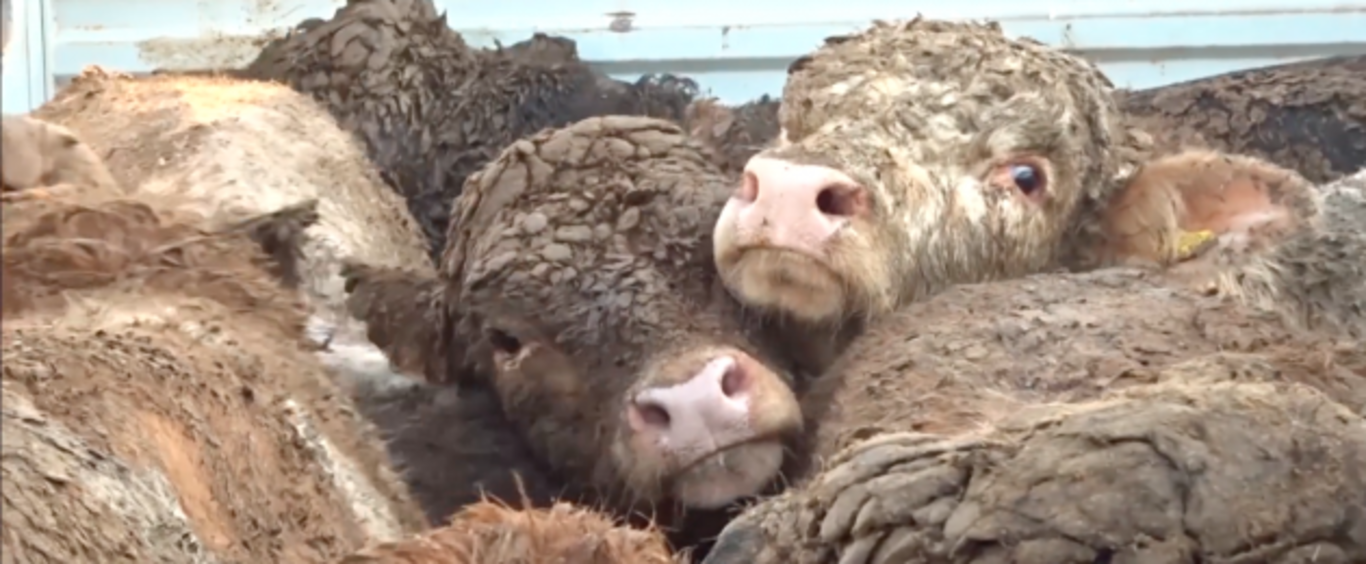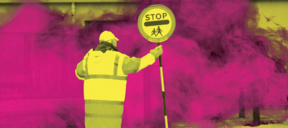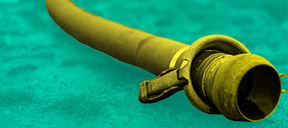‘A slow, terrible death’: The fate of Irish cattle exported outside of the EU
Noteworthy finds the State has little to no control over what happens to animals once they leave Ireland.
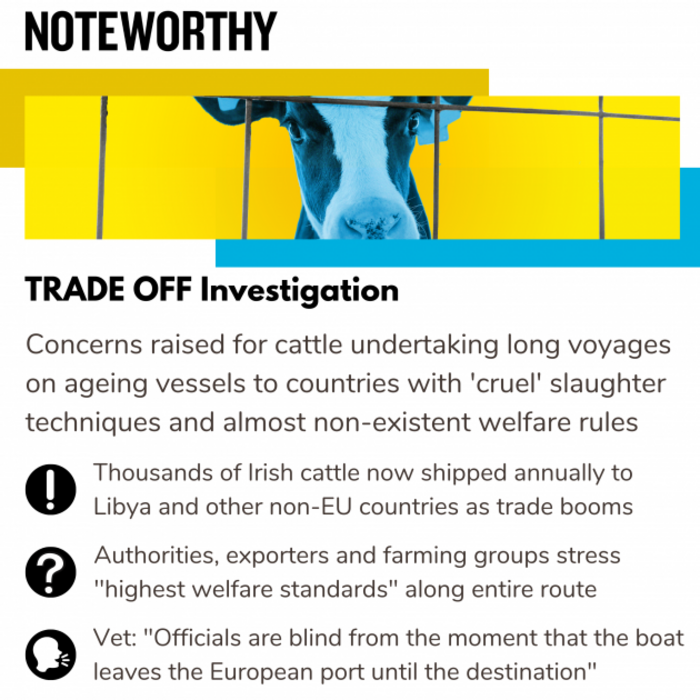
—
“EYE-STABBING, TENDON slashing, hoisting them to the ceiling by chains or ropes to contain them, and multiple throat cuts.”
According to Gabriel Paun, these are techniques that Animals International, the welfare organisation he works with, have filmed in slaughterhouses in North Africa and the Middle East, where, he says, it can take up to 30 minutes to kill a single fully conscious animal – “a very slow and terrible death”.
Many of the countries where footage has been obtained over a number of years, and as recently as this summer, are key destinations for Irish cattle exported in their thousands every year.
Irish authorities, the export trade and farming groups are keen to stress high welfare standards are followed, with recent changes making national rules more strict than already stringent EU laws.
Yet, according to multiple animal welfare groups, Irish and EU rules don’t hold up once the cattle leave European shores – with concerns raised over conditions on ageing vessels and cruel slaughter in destination countries where welfare rules are almost non-existent.
Our investigation finds that the Government does not monitor animals once they arrive at the port of destination countries. We also show that vets were on board just two shipments to non-EU countries since a commitment to increase their presence was made in the Programme for Government.
Deaths during journeys are also a concern with data compiled by Noteworthy revealing 128 cattle died on vessels and 183 were injured since 2018, according to official reports. This includes 14 deaths and 88 injuries so far this year, with respiratory issues the main cause noted.
As part of our TRADE OFF series on cattle exports, we examined the boom in the trade, including documenting loading of animals at ports, as well as the role the industry holds for Irish farming, and what changes, if any, can be made to tackle issues raised by welfare groups once animals leave Irish shores.
- In the final article of this series, we examine concerns raised over the welfare of unweaned calves during long journeys to mainland Europe
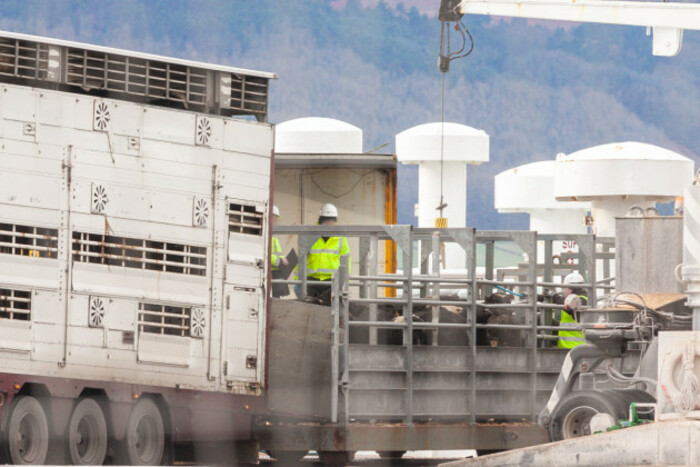 Cattle being loaded onto a vessel at Greenore Port destined for Libya
Cattle being loaded onto a vessel at Greenore Port destined for Libya
‘A booming industry’
Bringing in a handsome €123 million in 2021, the live export of cattle has been described by officials as “a critical part” of Ireland’s modern livestock sector. The industry is nothing new, however.
In the 1980s and 1990s, the EU gave subsidies for cattle exports outside of the bloc, causing a surge in exports to the likes of Lebanon and Egypt that quickly dwindled when subsidies were removed.
Now, the trade is increasing again, with Turkey and Libya acting as important markets in recent years, taking in over 100,000 head of Irish cattle between them since 2016.
According to Seamus McMenamin, manager of Bord Bia’s live exports sector, shipments to non-EU, or third countries, are “an important element” of Ireland’s livestock industry and ensure “competition by providing an alternative market outlet for farmers”.
Eddie Punch, the general secretary of the Irish Cattle and Sheep Farmers’ Association (ICSA), told us that the key benefit of the trade is not the financial gain – although important – but the “escape” from dependence on meat processors.
“It provides a real floor to underpin prices – if the factories try to cut prices too much, more cattle get exported and this mitigates against further price cuts.”
Welfare criticism of industry
While clearly beneficial to a range of Irish farmers in the beef and dairy sectors, the global live export trade, however, has received much criticism.
A 2021 report by Austrian experts – a judge, a vet and a law lecturer – found conditions in countries such as Turkey, Morocco, Jordan, and Egypt, all destinations for Irish cattle, are “cruel” and “in complete contradiction with European animal welfare legislation”.
Problems have also been documented in the Irish media over the past few years. In 2017, for example, Animals International recorded Irish cattle being unloaded after a journey of almost two weeks to Turkey covered in faeces and crammed into an open top lorry in full sun.
In November 2020, welfare groups provided the Department of Agriculture (DAFM) with footage of Irish cattle in a Lebanese slaughterhouse where methods used, they claimed, were “inhumane causing immense fear, pain and suffering to the animals”, including throats slit whilst fully conscious.
DAFM said that it does not comment on individual cases and that “any concerns or allegations relating to non-compliance outside the State should be provided to those competent authorities”.
While there is limited footage of Irish animals at slaughterhouses, according to Gabriel Paun of Animals International, the way animals are slaughtered in the Middle East, North Africa and Turkey are generally the same and include pain, distress and suffering to the animals.
This July, for example, the NGO took photos of a dead Irish bull in a Jordanian slaughterhouse. Although there is no footage of the slaughter, footage seen by Noteworthy from the same abattoir shows a bull in a trip floor box – commonly used in the Middle East to make the cattle fall – where its throat is cut multiple times with a short knife whilst still fully conscious.
The individual slaughtering the animal appears to be a teenager, while members of the public – including small children – are watching from just a few feet away without any barriers. Additional footage shows sheep being handled roughly and having their throats cut while fully conscious.
Under the Halal method, the animal’s throat must be cut with a sharp knife by a Muslim and blood drained out of the carcass. Under EU law, animals must be pre-stunned before slaughter except for Halal meat. In Ireland, any facility carrying out slaughter without pre-stunning must be approved by DAFM, with strict requirements on animal restraints, knives used and the need for a single throat cut.
- In the first part of this series, we revealed that thousands of Irish cattle are sent to North Africa through Spain on lower standards vessels than allowed under Irish law
While not able to comment on individual cases, Brendan Smyth, the chair of Veterinary Ireland’s animal welfare committee, told us that the organisation “would have concerns about the export of animals to third countries [non-EU] where welfare standards are not similar to EU welfare standards”.
The organisation, he said, supports the recent call by the Federation of Veterinarians in Europe (FVE) for revision of EU transport legislation, which includes calls for long journeys by sea vessels to be phased out and a halt to exports to destinations with unidentified welfare standards.
John Hallissey of the Irish Livestock Exporters Association told us that, while aware of footage shared by welfare groups of killing in streets and some abattoirs, “it’s not the market” Irish exporters are looking for, pointing to recent shipments to Libyan farms “superior to most of the European farms”.
“The guy that’s buying a shipload of cattle is buying €4 million worth of cattle. It’s a professional outfit,” Hallissey said, with cattle killed in slaughterhouses owned by the client “equivalent to the EU standard”.
 Straw being loaded on vessel transporting Irish cattle to Libya
Straw being loaded on vessel transporting Irish cattle to Libya
Highest standards ‘in the world’
The Department also said that exports meet the highest welfare standards above and beyond EU law. “Our work in this area is conducted on the basis that no one shall transport animals, or cause animals to be transported, in a way likely to cause injury or undue suffering to these animals,” a spokesperson told us.
Bord Bia is of a similar position, with Seamus McMenamin, the agency’s live export division lead, telling us its offices “consistently receive very positive feedback about the quality, health and performance of Irish cattle in export markets”.
This position is also held by Ireland’s farming groups, with the Irish Farmers’ Association (IFA) president Tim Cullinan stating in 2020 that the industry “operates to the highest animal welfare standards in the world”.
The EU has praised Ireland for its stringent regulations, including the need to return detailed journey logs and reports from the master of the vessel on sea conditions, temperatures, injuries and deaths.
There are also strict vessel approval rules and routine inspections by a vet and marine engineer, assessing the stability of the ship, the ventilation and water systems, and the animal handling facilities, among other criteria.
A 2019 European Commission audit found that Ireland is an outlier for having such a system in place “to minimise the risk for the welfare of the animals during the sea transport”. A further EU report in May 2021 found that Irish rules “exceed by far” the EU’s own transport welfare regulations.
‘Good on paper only’
Caroline Rowley of Ethical Farming Ireland (EFI) told us, however, that the animal welfare group has still documented breaches of Irish and EU law, including recent cases of bending of cattle’s tails that can injure the spine and hitting of cattle on the head with paddles and long sticks during loading.
Another key concern is conditions on the journey itself, with shipments regularly authorised when adverse weather conditions are forecast, even though this is not allowed under Irish rules.
Vessels should not depart when force six gales or above are predicted, yet, “this is happening all the time,” Rowley said. These winds cause vessels to “roll and pitch excessively”, she explained.
Since 2020, EFI has identified eight shipments that departed with predicted gale force winds of six and above, sending complaints to DAFM questioning why journeys were approved.
A report from the European Parliament last year also found that Irish authorities have allowed vessels to depart in rough seas, “posing a risk to animals on board and crew”. When asked about these shipments, the Department said that it does not comment on individual cases.
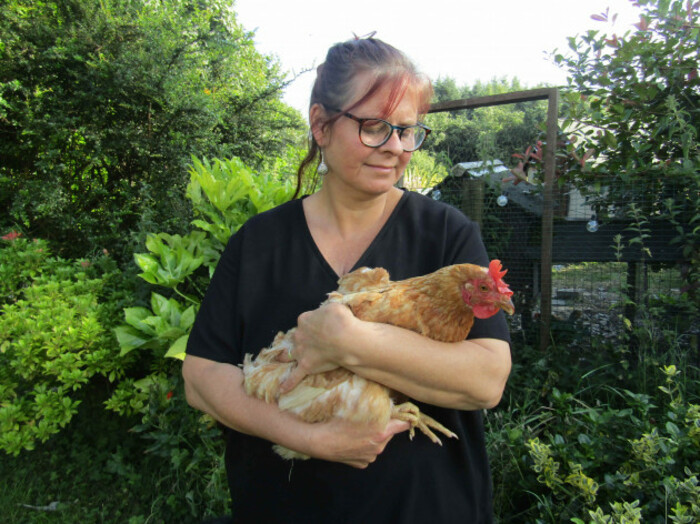 Caroline Rowley of Ethical Farming Ireland
Caroline Rowley of Ethical Farming Ireland
Deaths on journeys from Ireland
Maria Boada, a veterinarian with Animal Welfare Foundation, also told us journeys are “much more dangerous” than from other EU countries as they are longer with more adverse conditions. The Bay of Biscay off France and Spain – passed on the journey – is renowned for choppy seas and stormy conditions.
Other problems, Boada said, include heat stress, noise stress from ventilation systems, motion sickness, and respiratory illness caused by ammonia from manure. All of these issues, common on livestock vessels, are exacerbated by longer journey times from Ireland, she said, lasting in some cases up to two weeks from journey logs seen by Noteworthy.
“The sea is not like the Mediterranean that is quieter, more relaxed, and you have less losses of animals,” said Boada, one of the authors of a 2021 EU report on animal welfare on sea vessels.
Data compiled by Noteworthy shows there were 128 deaths on vessels and 183 injuries since 2018. On one journey to Libya, 17 cattle died, although the ship logs do not state the cause of death. So far in 2022, there have been 14 deaths and 88 injuries, with respiratory issues the main cause noted.
John Hallissey of the Irish Livestock Exporters Association told us that, while exporters have had some casualties, “we could have the same casualty at home [on the Irish farm]”.
He also said that there have been plenty of journeys with “zero mortality” and that the cattle generally gain weight on the journeys. Analysis of logs from 38 shipments between 2018 and 2021 show that 99% of the nearly 79,000 cattle exported arrived at the destination port alive.

Ships not up to standards
Even if most animals are arriving at the port alive, Rowley said there are concerns about the quality of the vessels and the potential for a major incident to occur.
Much like ships operating from other EU countries, the vessels approved to operate from Ireland are decades-old converted car transporters or cargo vessels, and are susceptible to breakdown and other structural issues.
The North Star 1, for example, originally built as a car transporter in 1983, suffered engine failure out at sea in early 2014 after picking up cattle in Ireland destined for Libya and was detained for 45 days.
This vessel was inspected three times in 2019 and 2020, with 19 deficiencies discovered, including issues with the fire detection systems.
Problems with livestock vessels are common in the EU, with the European Parliament finding that half of them “pose a huge welfare risk for the animals transported”.
The Department said it “does not comment on individual cases”, while the companies operating the vessels from Ireland did not reply to requests for comment.
No control in destination country
Another issue consistently raised is the welfare of cattle once they exit the vessel in the destination country, with a European Parliament inquiry last year finding that EU authorities cannot ensure animals are effectively protected from injury, pain and suffering when they arrive in non-EU countries.
“This is a huge problem,” according to AWF’s Boada, as “the official authorities are totally blind from the moment that the boat leaves the European port until the destination”.
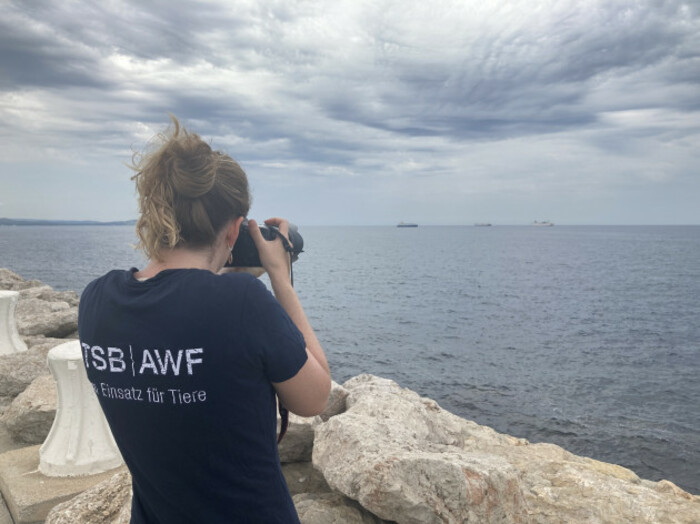 Vet Maria Boada documenting live export vessels
Vet Maria Boada documenting live export vessels
The Department said that it “does not have or hold information on animals once they move outside of Ireland” and that, once they arrive in the importing or transit country, “they are subject to relevant rules applying in those countries”.
Various approved journey logs seen by Noteworthy show that the port of destination is normally listed as the final destination but this is not where the cattle’s journey ends as they would travel from here to holding facilities, farms or slaughterhouses.
As the document trail usually ends at the port, authorities “don’t have a clue” how cattle are treated after they arrive, according to Boada.
“The competent authority is responsible for ensuring the regulation is enforced right up until the final destination, which would be the farm or the feedlot, but this isn’t taken seriously,” according to Ethical Farming Ireland’s Rowley.
“We don’t know what happens to animals once they disembark at the destination port because that’s where the paper trail ends,” she added.
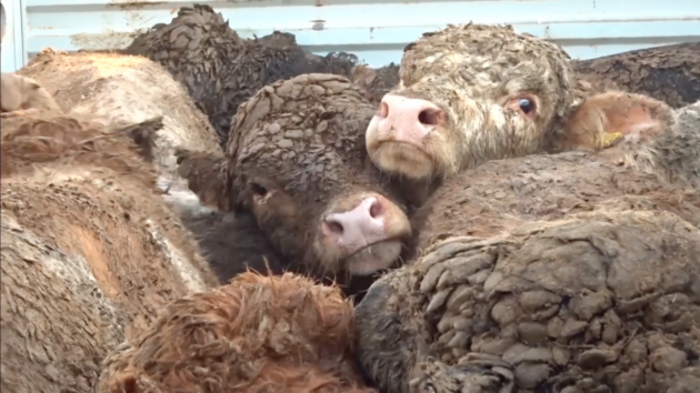 Irish cattle covered in excrement on truck in Turkey
Irish cattle covered in excrement on truck in Turkey
In October 2020, it was announced that the Department would provide “additional resources to monitor welfare standards”, including increasing vet on journeys to non-EU countries as committed to in the Programme for Government (PfG). To date, however, there has been very little activity.
Data released to Noteworthy by DAFM shows that vets were on board on just two occasions – to Libya and Jordan – from 14 shipments since the release of the PfG in October 2020.
On both occasions the vet did not witness the unloading of animals at the port or travel any further to a holding facility, farm or slaughterhouse.
According to AWF’s Maria Boada, “unless the official vet will travel all the time with the animals” and to the final destination, ensuring that EU animal welfare rules are enforced is “impossible to control”.
John Hallissey of the Irish Livestock Exporters Association said that it is not true that there is no follow-up once the cattle arrive at the port, and that exporters “are responsible for the animals right through from start to finish” of the journey.
“They don’t have European laws in Libya but the transport is perfect,” he said, as an example, with Libya currently the key destination point for Irish cattle outside of the EU.
“There is no danger of the animals being injured,” he said as the buyers have financial interest in these animals and have to make sure those animals get to the farm in “perfect condition”.

Writing on the wall?
Despite assurances from exporters, farming groups, and the Department that the Irish industry has welfare at its core, NGO concerns are increasingly being heard by policymakers.
Earlier this year, for example, the European Parliament put forward proposals for much stricter rules in animal transport regulations that are under review by the EU.
This summer, the governments of Belgium, Denmark, Netherlands, Germany, and Sweden voiced concerns, calling for a ban on long seas journeys, as well as banning exports “where the third country’s legislation is not equivalent to the EU’s standards”.
The Department of Agriculture said that it supports any review of regulations but “continues to insist that such a review must be based on scientific knowledge and evidence” and consideration of the implications of future changes for the farming sector.
John Hallissey said the real “harrowing stories” are coming from other EU countries with “nothing to do with us”. He added: “You can’t tarnish the reputation of the guys that do a professional job from start to finish because of the reputation of others.”
Ethical Farming Ireland’s Rowley, however, said that the welfare implications of the trade needs to be put front and centre of the debate in Ireland and across Europe. If this was the case, she said, “ultimately export outside the EU should be stopped”.
—

Our TRADE OFF investigation was carried out by Niall Sargent of Noteworthy. It was proposed and funded by readers of Noteworthy, the investigative journalism platform from The Journal.
You can support our work by submitting an investigation idea, funding a proposed project or setting up a monthly contribution to our general investigative fund HERE>>
We also have a number of other projects related to farming and animal welfare.

